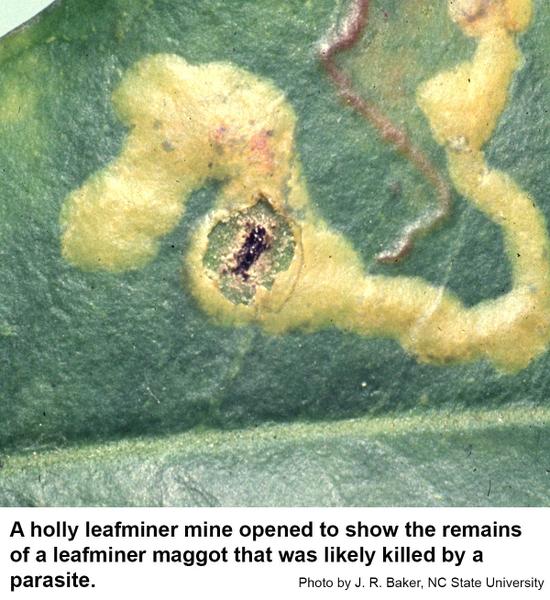Description and Biology
Hollies are sometimes damaged by leafminers. Each species of holly has its own leafminer species. The native holly leafminer, Phytomyza ilicicola, only feeds on the foliage of American holly and its cultivars likely including Foster's holly. The holly leafminer, Phytomyza ilicis, is a European species that feeds primarily on English holly. Additionally, the “inkberry leafminer”, Phytomyza glabricola, infests inkberry. Adults of holly leafminers are small (up to 1/8 inch), black and gray flies with dark reddish eyes. Females are generally more active than males. Eggs are white, oval and very, very small. Maggots are pale-yellow, legless, and tapered from front to back with its head retracted into the body. Pupae are reddish brown, 3/16 inch long, and uniformly tapered to blunt points at both ends. Maggots molt twice as they grow. The last stage overwinters. In March and April the maggots pupate, and adult flies begin to emerge in May. Females live about three days and males survive only two. Females insert eggs into the undersides of newly leaves, causing tiny, green blisters there. Eggs hatch in about four days. The larvae tunnel inside the leaves causing yellowish brown mines that usually have one larva per mine. Each serpentine mine eventually broadens into a blotch in which the maggot pupates inside its last larval skin. Just before pupating, maggots prepare a circular exit leaving a thin layer of cells on the upper surface of the leaf. Leafminer flies do not have sharp mouthparts so females pierce the leaf with their ovipositors. Both females and males feed on the sap that exudes from the wound. Feeding causes puncture wounds on the upper leaf surface. Leafminers of deciduous hollies have several generations per year, whereas the leafminers of evergreen hollies have only one generation per year.
Host Plants
Each species of holly seems to have its own species of leafminer fly. These leafminers make serpentine mines in the leaves of hollies. They often leave tiny circular scars from egg-laying and especially feeding punctures. Heavily damaged leaves often fall prematurely.
Residential Recommendations
Infested holly leaves sometimes drop to the ground before adults emerge. Gathering and destroying leaves that have dropped prematurely helps reduce the next generation of leafminers. Because leafminers are plagued by parasites, it may be better to rely on parasites to suppress leafminers than to apply pesticides that might eliminate the parasites and thus allow the leafminers to become even more destructive. If parasites are not effective in preserving the aesthetics of a specimen shrub or tree, insecticides can be used as a last resort. To time a pesticide application with precision, it would be good to put some infested leaves in a dry plastic bag in the shade where the bag will not be completely out of sight (and thus forgotten). When the small, dark flies emerge inside the bag, that is the best time to apply some sort of contact pesticide. Systemic insecticides should be applied just after the new growth emerges. If the leafminers are noticed after they are already mining inside the leaf, systemic pesticides (pesticides absorbed and translocated by the plant) such as acephate (hard on beneficial insects), imidacloprid, or neem products should be given consideration for control. These are available in most garden centers.
References
- Holly Pest Management Calendar. Baker, J. R. 2008 (last review). PDIC Factsheets, NC State Extension.
- Holly Leafminer (Phytomyza ilicicola). Anonymous. No Date. University of Georgia Extension.
- Leafminer Flies. Frank, S. 2010. Entomology Insect Notes, NC State Extension Publications.
- Molecular Phylogenetics of the Holly Leafminers (Diptera: Agromyzidae: Phytomyza): Species Limits, Speciation, and Dietary Specialization. Scheffer, S. J. and B. M. Wiegmann. 2000. Molecular Phylogenetics and Evolution 17(2):244-55.
- Native Holly Leafminer. Hoover, G. A., Sr. 2003. PennState College of Agricultural Sciences, Department of Entomology, Insect Advice from Extension, Fact Sheet.
- Insect and Related Pests of Shrubs. Baker, J. R. ed. 1980. NC Agricultural Extension Service publication AG-189. 199 pp.
- Extension Plant Pathology Publications and Factsheets
- Horticultural Science Publications
- North Carolina Agricultural Chemicals Manual
For assistance with a specific problem, contact your local N.C. Cooperative Extension Center.
This Factsheet has not been peer reviewed.
Publication date: Aug. 9, 2016
Reviewed/Revised: Oct. 1, 2019
Recommendations for the use of agricultural chemicals are included in this publication as a convenience to the reader. The use of brand names and any mention or listing of commercial products or services in this publication does not imply endorsement by NC State University or N.C. A&T State University nor discrimination against similar products or services not mentioned. Individuals who use agricultural chemicals are responsible for ensuring that the intended use complies with current regulations and conforms to the product label. Be sure to obtain current information about usage regulations and examine a current product label before applying any chemical. For assistance, contact your local N.C. Cooperative Extension county center.
N.C. Cooperative Extension prohibits discrimination and harassment regardless of age, color, disability, family and marital status, gender identity, national origin, political beliefs, race, religion, sex (including pregnancy), sexual orientation and veteran status.




